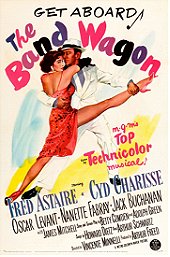Revisiting The Band Wagon only heightened some of my first and distinct impressions of the overall film. It is a series of glorious, isolated moments that rank among the best of the movie musical and MGM’s already hefty output during this era, but when strung together it does not add up to something truly great. The threadbare plot and hodgepodge ideas feel in search of a deeper function until the next big number comes along. It is all an explosion of color and the athletic, sexy things the human body can do in dance, which is sometimes more than enough.
The Band Wagon concerns a fallen movie star (Fred Astaire), displaced by changing tastes/times, looking for a career rebound and finding it in the ramshackle Broadway show presented to him by his two friends (Oscar Levant and Nanette Fabray as an in-joke Betty Comden and Adolph Green). What follows is a behind-the-scenes glimpse of putting on a show – writing process, assembling the creative talent, out-of-town tryouts, and finally, the big opening night. A persistent tone of wistfulness, if not downright melancholia, pervades over the whole enterprise as the ephemeral nature of “putting on a show” is highlighted again and again and again.
It makes sense that Astaire would take the lead in a film like this as contemporaries like Gene Kelly were too proletariat in comparison. The film needed a star who seemed self-possessed, and Astaire’s commitment to perfectionism was well-known at the time. Co-star Fabray said, “Fred rehearsed until he drove you crazy.” The results show as Astaire’s penchant for being a one-man whirling dervish is only underscored by the likes of “By Myself,” “Shine on Your Shoes,” and nearly stealing the show from his partners in “That’s Entertainment,” where the four performers practically show you their bruised, bloodied, and exhaustively rehearsed bodies and demand for our applause and love. They get them, oh boy do they get them.
Without a comparable leading lady, think the likes of Rita Hayworth, Ginger Rogers, or Judy Garland, Astaire would come across as a strangely sexless, nearly asexual screen presence for a dancer. He was not a generous movie dancer, and he needed a strong partner to shore up his weakness or match his intensity. Cyd Charisse matches him when it comes to dancing but is inert at this point in her acting career. She is only halfway there as a sparring partner for Astaire, but a lot of the blame for that goes to MGM’s insistence on polishing out the native accent and charm of Charisse and making her into another transatlantic bombshell.
Forgiveness for her lack of sexual chemistry and inert acting abilities aside, she is a stellar dance partner for him. “Dancing in the Dark” is a romantic ballet between the two that finds Charisse throwing her body around in ways that merge the transcendent, the euphoric, and the erotic in mystical ways. This was the power of her as a dancer. We see the two of them matching in technical skill and expanding into something more and greater than their individual talents.
Then comes “Girl Hunt Ballet,” a bit of a goof on Gene Kelly’s dream ballets in his films. It is also one of the greatest pieces of musical filmmaking that Minnelli ever created. Charisse and Astaire roll through a staggering number of emotions through their bodily pantomimes, and the only comparable acting equivalent would be the torrent of verbiage that comes from performing Shakespeare. It is a highpoint for all involved with Astaire as film noir antihero, Charisse as the femme fatale, and some of the jazziest choreography I’ve ever seen. Charisse’s reveal of her red tasseled dress is filled with a carnality and grace that makes going to the movies a perfect excuse to watch beautiful people doing interesting things with their bodies.
Although, if you’re anything like me, you will have noticed that the various scenes for the Broadway show make absolutely no sense when strung together. (Yes, even factoring in the revue makeover.) They are merely a body of work that exist independently from each other to entertain us. (Seriously, what the hell is that “Triplets” number? I’ve seen the film twice and still am flabbergasted by it.) The connecting tissue is shambolic, but the final results, the stuff that lingers longest in the mind, is some the purest, best musical ephemera of the decade. That’s entertainment? Yeah, that’s entertainment. (La la la la la la.)
 Login
Login